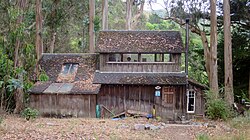Druid Heights
Counterculture enclave in Marin County, California From Wikipedia, the free encyclopedia
Counterculture enclave in Marin County, California From Wikipedia, the free encyclopedia
Druid Heights was a counterculture enclave in Marin County, California, U.S., The property was purchased in 1954 by poet Elsa Gidlow, and subsequently the land was split with carpenter Roger Somers and his wife Mary. In 1956, Elsa named her portion Druid Heights and today the entire site is called by this moniker although in practice the neighbors seldom used the name. In actuality, the community was not a monolith, but the neighborhood shared common values and responsibilities concomitant with the remote site's lack of services. It had no city water system, no sewers, and no city maintenance for the three mile dirt road that gave them access to their properties. The neighbors, including others along the road, had to pool money and resources to maintain these vital services and these challenges demanded they work together in harmony. The remoteness and uniqueness of the site attracted various countercultural movements and many figures of the San Francisco Renaissance.[1]
Druid Heights | |
|---|---|
Counterculture Enclave | |
 | |
| Coordinates: 37°53′21.174″N 122°33′52.9596″W | |
| Founded by | Elsa Gidlow, |

Druid Heights was, by its founder Elsa Gidlow, jokingly called an "unintentional" community located on the southeast flank of Mount Tamalpais in Marin County, California, about a mile from the Pacific Ocean.[2]: 267–268 The property was initially inhabited by carpenter Roger Somers and poet Elsa Gidlow, along with their partners, on five acres of a former chicken ranch.[1] Gidlow purchased the acreage and then legally split the parcel in 1954 so she could share it with carpenter Roger Somers and his wife Mary.[3][4][5] In 1956, Elsa gave her portion, approximately two acres, the name Druid Heights in honor of two female writers, the revolutionary and teacher of Irish lore, Ella Young (the Druid), and Emily Brontë (author of Wuthering Heights)
The community members, sometimes separately and other times together, allowed the acreage to be a meeting place for three countercultural movements in the United States, including the Beat Generation of the 1950s, the hippie movement of the 1960s, and the women's movement of the 1970s.[1] It also, through the efforts of Elsa Gidlow, became a refuge for many famous figures of the San Francisco Renaissance including her friends Kenneth Rexroth and former resident of the Heights, Pulitzer Prize winner Gary Snyder.

Accessible by a dirt road connected to Muir Woods Road, the two properties occupied a now split five-acre ranch formerly known as the Haapa Property. On his portion, Somers, a free spirited and hard working craftsman, was influenced by Japanese architecture and American architect Frank Lloyd Wright. He built or remodeled many of the structures with the help of organizational skills and common sense from furniture designer and later the third owner, Ed Stiles.[6] Gidlow was fond of decorative gardening and organic agriculture, and she grew vegetables for herself and shared the excess with other people in the area.[7]: 136
Seeing a broader purpose for her portion of the land, The Society For Comparative Philosophy, begun in 1962, was established here as a non-profit by Elsa Gidlow and Alan Watts aiming for a broad vision approach to "studies of humanity's relation to nature and the universe."[8]: 360 They purchased the converted ferry boat Vallejo to "be headquarters for the Society and site of seminars and other events," and the Heights could therefore be kept a closely guarded secret enjoyed by insiders and invited guests.[8]: 361 The Society fell on hard times after the 1973 death of Alan Watts, but in his name and with the help of a solid board of directors, it revived and continued until Gidlow's death in 1987.
Gidlow had planned to turn Druid Heights into a pay-as-you-go retreat for artists, but after the National Park Service acquired the land using eminent domain in 1977, it could no longer host temporary guests, only legal tenants.[9] Located above Muir Woods National Monument, Druid Heights was acquired by the National Park Service in the 1970s[10][3] and is now on the National Register of Historic Places.[11]
"With [Gidlow's] skill as a gardener and [Somers'] as an architect they transformed this area into a paradise, a Garden of Eden...All this they accomplished with imagination and muscle...It has what people who are only rich find so frustrating, because you cannot buy it with money."
Alan Watts[2]: 268
There are approximately 16 historic buildings and structures in what is today commonly called Druid Heights[11] with the most important structure, poet Elsa Gidlow's own house, seriously endangered due to a lack of maintenance. Remaining structures include:

Marcy Mendelson directed and produced a documentary about the location called Druid Heights, and stated that the location was a vortex of social and artistic energy and reminiscent of the Shire.[14]
Seamless Wikipedia browsing. On steroids.
Every time you click a link to Wikipedia, Wiktionary or Wikiquote in your browser's search results, it will show the modern Wikiwand interface.
Wikiwand extension is a five stars, simple, with minimum permission required to keep your browsing private, safe and transparent.